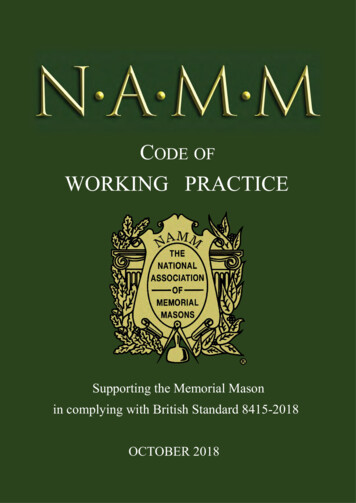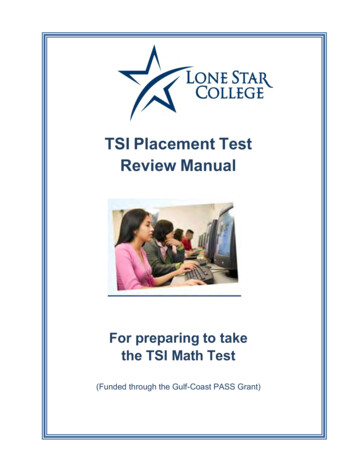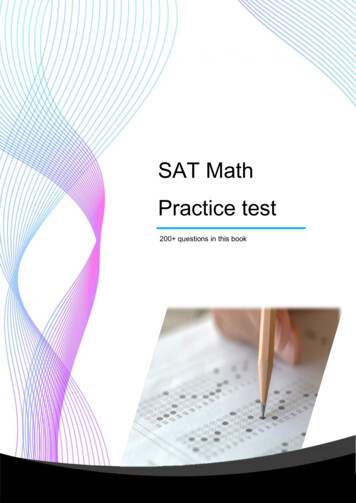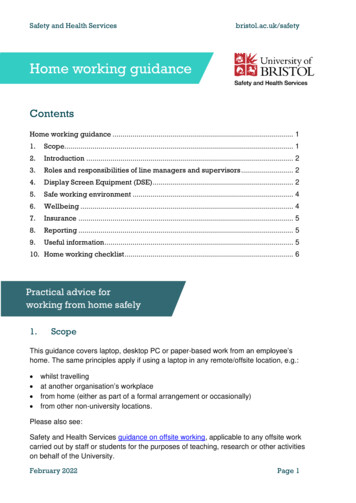
Transcription
CODE OFWORKING PRACTICESupporting the Memorial Masonin complying with British Standard 8415-2018OCTOBER 2018
Page 1The Code of Working Practice for Memorials in Burial GroundsAnd Other Commemorative SitesINDEX Showing SECTION Numbers1GENERAL STATEMENT2STANDARDS FOR FIXING MEMORIALS3CEMENTS AND ADHESIVES4ADHEASIVES DOWELS5DOWELS AND FIXINGS6FOUNDATIONS7GROUND SUPPORT SYSTEMS8WALL PLAQUES9TABLETS, PLAQUES AND OPEN BOOKS10LAWN MEMORIALS11MONOLITHS12CANOPIES AND ARCHES13CROSSES AND FIGURES14FULL GRAVE MEMORIALS WITH HEADSTONES15FULL GRAVE MEMORIALS WITH LEDGERS16MOD STYLE HEADSTONES17CLEANING MEMORIALS18LISTED AND HERITAGE MONUMENTS19REPAIR AND REINSTATEMENT OF EXISTING MEMORIALS20FINISHES21LETTERING22SAFETY ASSESSMENT23TALL AND LARGE MEMORIALS24REVISION PAGE25GLOSSARY Copyright NAMM October 2018
SECTION 1Page 2GENERAL STATEMENTThe aim of the NAMM Code of Working Practice is to support the memorial mason in complyingwith current BS 8415 guidance and to ensure that the customer is provided with a memorial that isof good lasting quality and fit for purpose, requiring as little structural maintenance as possible.Memorials must be constructed to comply with the Code of Working Practice and BS8415guidance current at the time of fixing. If a memorial is dismantled for any reason, then it must bere-fixed to the latest specification.The memorials supplied by members of the Association shall be of sound natural quarriedmaterials and subject only to those variations in colour, natural characteristics and regionalvariations as are accepted by the trade and approved by NAMM General Council and theTechnical Committee.The suitability of a particular type of natural stone is determined by understanding the pastperformance of the materials used for monumental work in the United Kingdom.The minimum thickness recommended for structural parts of a memorial over 625mm high is50mm for slate and 75mm for all other stones. Thinner materials can be used but only in situationsthat carry little or no weight.All components used in the construction of a memorial, including the dowels, must be of sufficientstrength for the memorial to be self-supporting.Workmanship must always be as good as possible with Members adhering to the principles andcode of ethics of the Association at all times.Masons must understand the Health and Safety implications of their work to themselves and othersand appropriately manage risks such as dust, hazardous chemicals and the use of tools andmachinery. Suitable Personal Protective Equipment must be used at all times.Although not an exhaustive list the following links provide further useful guidance.http://www.hse.gov.uk/ The Health & Safety at Work Act (1974)http://www.hse.gov.uk/pubns/indg163.htm Risk Assessment.http://www.hse.gov.uk/pubns/indg463.htm Control of Silica Dust.http://www.hse.gov.uk/coshh/ COSHH (Control of Substances Hazardous to Health)http://www.hse.gov.uk/riddor/ RIDDOR (Reporting of Injuries, Diseases and DangerousOccurrences g.htm Manual inery/loler.htm LOLER (Lifting Operations &Lifting Equipment achinery/puwer.htm PUWER (Provision and Useof Work Equipment Regulations) Copyright NAMM October 2018
SECTION 2Page 3STANDARDS FOR FIXING MEMORIALSThe Association, together with a consultant structural engineer, has tested, calculated andrecorded the design strength of various sized memorials of various materials and methods offixing. The construction and fixing methods shown in the Code including approved dowel sizes arenationally accepted standards and were first incorporated into BS8415.2005. The NAMM Code ofWorking Practice is continually updated to ensure full compliance with current BS 8415 guidance.Whilst the systems described in the Code are not the only way of fixing a memorial, alternativemethods must achieve the minimum standards set out in the NAMM Code in order to meetBS8415.2018.Memorials in which the highest part of any component is greater than 625mm above ground levelshall be designed to withstand a horizontal load of 70kg applied at its apex or 1.5m from theground, whichever is the lower, with the load being applied in the most critical direction.See section 7 Ground Support systems.A memorial cannot be expected to withstand a determined vandal or catastrophic event.The recommendations in this Code assume that the grave area has been suitably prepared by theBurial Authority for the safe erection of memorials as permitted in its regulations.Masons may be required to vary fixing methods to comply with regulations outside the Code, or ifso directed by a Structural Engineer employed by the Burial Ground management.Some Burial Grounds install their own foundations or supply bases in which case the mason mustcomply with written instructions for that Cemetery. However, the Burial Authority must takeresponsibility for any part of the memorial construction it provides such as foundations and ifrequested issue appropriate dispensation to the mason.Authorities are entitled to insist that a large monument be built to current Building Regulations andin any such case must provide a written specification.Memorials and the surrounding areas must be left in a clean and tidy condition.Reinstated MemorialsWhen reinstalling any memorial such as those previously removed for remedial work or adding aninscription etc or if re-fixing a failed memorial (when laid down or removed as safety measure ) allcomponents such as foundations, dowels and method of fixing must comply with currentstandards. See section 10This document will be regularly updated in the event of new materials and techniques beingapproved as appropriate in the construction of memorials.Copyright of this publication and its content remains with the National Association of MemorialMasons and may not be copied or reproduced in full or in part without the express writtenpermission of the Association. Copyright NAMM October 2018
SECTION 3Page 4CEMENT AND CONCRETE3.1 Cement used in memorials within burial grounds and memorial sites shall be in accordancewith BS EN 197-1 type CEM I, strength class 42.5.3.2 Jointing and pointing materials used in memorials within burial grounds and memorial sitesshall conform to BS EN 447.3.3 Mating surfaces to be joined by cement should be roughened and free of surface dust andshould be damp, but without any free water.3.4 For lawn memorials, excluding any openings for vases, dowels, anchors etc, it should be aimedat achieving 100% coverage of the available contact area between the memorial base andfoundation slab, so ensuring there are no voids or paths for water to penetrate the joint. The jointwhen put together should be ‘worked’ into place, to give sufficient adhesion or ‘vacuum’. Isolateddabs are not acceptable as these could allow the penetration of water, which upon freezing wouldexpand causing joint weakness and possible failure.3.5 Cement quality is entirely dependent on the way that it is mixed. Cement should be date dryand correctly stored. It should be mixed with as little water as possible and thoroughly worked for 5minutes to a consistency of smooth thick cream. If cement is not mixed thoroughly or mixed tooquickly its strength and duration of workability will be reduced, the addition of more water oncemixed will also weaken its adhesive properties. Cement paste shrinks and dries as it hardens. Themore water used the more shrinkage and the less strength.3.6 Neat cement paste may take 6 hours or more to harden and does not reach full strength untilthe 28th day. Early excessive pressure loading may cause the joint to fail.3.7 Cement mixing should always be left until the last moment and only enough prepared for theimmediate work in hand.3.8 Work should not be carried out at temperatures below 5 C due to the risk of the mixing waterfreezing before it can react with cement.3.9 CEMENT APPENDIXThis advice is based on information provided by the British Cement Association (BCA).Cement when used correctly is perfectly suited to our use, cement should NOT be used beyond itsdeclared shelf life or use-by-date.Cement is manufactured in accordance with the British and European Standard BS EN 197-1 andis CE marked. Materials suitable for our applications are:CEM I Portland cement, once known as Ordinary Portland cement (OPC). This provides thehighest early strength but CEM II may be more readily available. CEM I is also available as WhiteCement.CEM II/A-L or CEM II/A-LL Portland Limestone Cement. Contains up to 20% limestone fines.CEM II/B-V Portland fly ash cement. Contains up to 35% fly ash.CEM II/A-S or CEM II/B-S Portland slag cement. Contains up to 20% or 35% slag.Due to the inclusion of a secondary main constituent CEM II cements are slightly less prone toearly age shrinkage but do not provide as much early strength as CEM I cement. CEM I andCEM II cements both take 28 days to develop full strength. Some cement contains a plasticisingadditive, which provides improved frost resistance. Copyright NAMM October 2018
SECTION 3Page 53.10 White Cement can be used for pointing marble, for this usage the addition of fine marble dustcan improve workability and help reduce shrinkage, white cement can also be coloured for otherapplications using approved additives in accordance with manufacturer’s instructions. .3.11 Lime Mortar Lime mortars are generally used on stone buildings and the material is notusually appropriate for memorials other than those constructed from Limestone. Lime mortar canbe acquired readymade at various strengths and formulations from specialist suppliers who areable to match existing mortar and supply data sheets which is beneficial when undertaking worksuch as the renovation of listed monuments. Special care and appropriate PPE must be wornwhen using Lime Mortars as they can cause serious burns and other skin problems.Concrete for foundations should ideally be mixed by machine.3.12 Concrete used in the foundations of memorials within burial grounds and memorial sites shallconform to BS EN 206-1. The characteristic compressive strength of the concrete at 28 days shallbe not less than 30 N/mm2.3.13 Concrete that is to be used for memorial bases, foundations or cast on site, should always beto the highest specification possible. In situ foundations should be allowed to cure for at least 14days before fixing takes place (28 days preferable)3.14 Concrete consists of cement, washed sand, aggregate and clean water (fit for drinking).Where there are sulphates in the ground, sulphate resistant cement must be used.3.15 Reinforcing steel used in the concrete foundations of memorials within burial grounds andmemorial sites shall conform to BS 4449.3.16 If additives are used i.e. concrete antifreeze or plasticiser, then the manufacturer’s guidancemust be followed.3.17 The sand and aggregate should be mixed first. This is often purchased ready mixed andcalled ballast. Concrete should be mixed before placing and the cement should be added last asany dampness in the ballast starts the cement setting process.3.18 After mixing the cement into the dry mix, add minimum amounts of water allowing for anydampness in the ballast, so that when tamped just a very fine film of water rises to the surface.3.19 Cement sets twice as quickly in the summer at temperatures above 20 C than in winter at5 C.The laying of concrete should not take place when the temperature is below 5 C. When frost isforecast it should be covered to protect it.3.20 Concrete is normally mixed in proportion: 1-part cement, 2 parts sand and 4 parts aggregateand can mixed by weight or volume, provided allowance is made for water content. Concrete usednear the sea or other saline environments should be stronger: 1-part cement, 1.5 parts sand and 3parts aggregate. If concrete is mixed by volume the same container should be used to measureeach portion.3.21 Placing of concrete should be within 30 minutes of mixing. Once placed it should be tampedto remove air bubbles. After trowelling any surface water should be taken off. Excessive waterreduces the strength of the concrete and causes shrinking when setting.3.22 Any mixed concrete, once the setting has started, must not be remixed with more water butshould be discarded.WEIGHT Dry concrete 300 x 300 x 300mm 68kg - Approx. 2400kg/m³ Copyright NAMM October 2018
SECTION 4Page 6ADHESIVES4.1 Flexible Bonding and Sealing Agents selected shall meet a performance class specified in BSEN ISO 11600 and be appropriate to the expected joint movements. The product must be suppliedwith a manufacturer’s guarantee stating that the product is fit for purpose when used with naturalstone, granite or marble and that the product’s curing temperature is suitable to the UK climate.4.2 Styrene Free Polyester Resin is a hard setting material, which can be used for fixing the rodsin the ‘Bolting Method’, for lawn memorials and fixing rest(s) to a plaque. When using a polyesterresin, all surfaces need to be dust free and dry and the work should be carried out in a workshopwith a dry atmosphere.4.3 CAUTIONARY NOTE: Polyester Resins have been used successfully. However deteriorationhas occurred over a period of time and failures have caused problems with memorials. Pleaseconfirm from the supplier that the resin is fit for purpose.4.4 PVA waterproof adhesive can be added in small quantities to cement to improve its strengthwhen making repairs. PVA adhesives can be used for repairing Lime and Sandstone, dowels shouldbe added to provide additional support to larger repairs.4.5 Polymer or Silicone based adhesives are generally unsuitable for fixing the structural parts ofthe memorial. These adhesives are suitable for secondary fixings such as photo plaques andsmall figures.4.6 MS POLYMER comes under BSEN ISO 11600; 2003 A1:2100 Building construction.Jointing products. Classification and requirements for sealantsCan be used to Seal jointsAttach ceramic plaquesAttach small vases to basesMS Polymer should not be used to replace cement to “bed/join” structural components of naturalstone together.Not all MS Polymers are suitable for natural stone – and may require a relatively high curingtemperature in comparison to normal UK conditions. Always check data Sheets for correct usage.Some MS Polymers can have a curing time of 72 hours or even longer, usually requiring atemperature of 5 degrees and upwards.If the temperature is not constant for instance it severely drops overnight, it can take much longerto “set” and may seriously reduce its bonding ability.4.7 RESINIs hard setting usually comprising of “two” compounds to be mixed togetherIt should not be used to replace cement to “bed/join” two pieces of natural stone togetherSOME Resins can be used for small repairs, it comes in colours and is easy to work to blend in tostone, curing time will be affected by temperature, hot weather will decrease curing time and verycold weather will retard setting. Always check data sheets for correct usage.Resin is not suitable for repairs on soft stone. Copyright NAMM October 2018
SECTION 5Page 7DOWELS, AND FIXINGSStainless steel dowels were first introduced by NAMM in 1996, the NAMM doweltable is an Industry recognised standard derived from rigorous component testingfinanced and undertaken by NAMM and has been reproduced with NAMM consent inBS8415-2018 and all previous BS8415 publications.Above some examples of testing from NAMM component testing archives.Dowel sizes for hard Limestones Marble Slate and Granite12mm x 2Minimum LengthintoPlateBase75mm50mmMaximum HoleDiameterIntoIntoUpperLowerSection Section16mm16mm12mm x 275mm50mm16mm20mmOver 63mm16mm x 275mm75mm20mm24mm625mm to915mm (3ft)Over 63mm16mm x 275mm75mm20mm24mm915mm to1220mm (4ft)Over 75mm16mm x 2100mm75mm20mm24mm1220mm (4ft)Over 100mm25mm x 2100mm100mm30mm35mmMemorial SizeHeight ofApexUp to andincluding625 mmNominal Dowel SizeThickness ofVerticalComponent50mm minimumDiameter50mm to 63mm(24” 5/8 )For memorials over 1200mm increase length of dowel into headstone 25mm every 300mm Copyright NAMM October 2018
SECTION 5Page 8Dowel sizes for soft Limestones and SandstoneMemorial SizeNominal Dowel SizeThickness ofVerticalComponentDiameter75mm12mm x 3 75mm50mm16mm20mm625mm to915mm (3ft)75mm12mm x 3 100mm75mm16mm20mm915mm to1220mm (4ft)100mm16mm x 3 150mm75mm20mm24mmHeight ofApexUp to 625mm(24” 5/8)Minimum LengthintoPlateBaseMaximum HoleDiameterIntoIntoUpperLowerSection Section5.1 Materials other than Stainless Steel may become available in the future but theAssociation cannot recommend them until they have been satisfactorily tested for the useon memorials.5.2 A dowel is a length of solid stainless-steel rod that fits into two corresponding holes toalign and join pieces of stone together. The dowel is a structural part of the memorial.Dowels, cramps and other fixings must be Solid Stainless-Steel Grade 304 or higher. Thediameters of dowels shown in the Code are nominal sizes.5.3 Dowel holes must be drilled with great care to ensure the sides of the holes are notfractured in any way. Ensure the hole is accurately positioned and to the required diameterand depth.5.4 It is recommended to use wet core drill for this procedure. (percussion drills maydamage or weaken the stone)5.5 Where cement is being used to secure the dowel, all dust must be removed from the drillhole before filling and inserting the dowel, the dowel hole should be damp but with no freewater.5.6 When setting the dowel into the hole, ensure the cement goes all the way to the bottomof the hole and is worked into the sides ensuring there is no trapped air between the doweland the wall of the hole.5.7 When cement is mixed to the right consistency it will not come out of the dowel holesduring fixing.5.8 Fixing the dowels into the upper unit in the workshop and allowing the cement to set willsimplify final assembly on site and provide a more stable initial fix.5.9 All surfaces to be fixed with cement should be roughened to form a key for goodadhesion. This applies to all parts of the memorial except where the design of the fixingsystem being used dictates otherwise. All joints must be fully bedded, and properly pointedor sealed. Copyright NAMM October 2018
SECTION 5Page 95.10 To avoid hydraulic shock when bedding or jointing porous stones such as Limestoneand Sandstones, the jointing surfaces should be pre-wetted to the point where they nolonger readily absorb water5.11 The joint between a headstone and base must have two solid stainless-steel dowels,of appropriate grade and size, which can be smooth or threaded.5.12 If dowels are used that differ from the sizes shown in the DOWEL TABLE, the holesshould not be more than 4mm larger diameter than the dowel in the top section or 8mmlarger diameter than the dowel in the lower section.5.13 Dry Dowels are where the dowel is secured into only one of the adjoining holes. Theyprevent slippage and are often used to locate heavy pieces of stonework such as the basesof a built-up structure. For ledger slabs resting on kerbs or directly on a foundation, use thesame size dowels as for fixing kerbs. For all other memorials, use the height of the memorialas a guide.5.14 Dowel sizes for structural components of a memorial. The table shows minimumdowel sizes for standard memorials which are derived from comprehensive testing byNAMM Any variations must be fully calculated and the structure must be designed to theNAMM criteria shown in the Glossary. Stainless steel manufacturers and/or structuralengineers can assist in these calculations.5.15 Slate 50mm or thicker is strong enough to be used for headstones up to a maximumheight of 625mm and the dowel sizes in the first row of the Dowel Table should be followed.5.16 Slate Memorials over 625mm in height fixed with dowels on a foundation or baseshould not be less than 75mm in thickness.5.17. Where headstones do not require a ground anchor, the memorial base should besecured to the foundation using an approved lock down device, bolting method or dowels.Cramp (also known as a ‘Dog Cramp’)5.18 Cramps are shaped lengths of stainless steelsuitably bedded into a sinking (a groove), cut intoadjoining components to tie them together.Must always be used at 90 degrees to the joint.5.19 Position cramp drilled and recessed into foundationLength at least 150mm with 75mm over each sectionMinimum depth of leg 50mmDiameter of cramp rod 8mmIdeally drill so that joint is drawn togetherMust be cemented Copyright NAMM October 2018
SECTION 5Page 10Joggle5.20 A Joggle is the name for a mason’s mortise and Tenon, where one piece of material islet into another. This type of joint in memorials can create weakness and stress and is notrecommended unless there is also adequate dowelling. To calculate the length of thedowels, the depth of the joggle must be added to the length of the dowel shown in the doweltable. A joggle joint is acceptable when the whole thickness and at least 75% of the width ofthe material is set into a mating groove in the foundation or base. The depth into the baseor foundation of the joggle must be more than 75m.Bolting Method for fixing plate (headstone) to base.5.21 Threaded dowels (rods) and nuts must be of different grades of stainless steel(e.g. dowels could be A4 grade, nuts A2) to prevent the possibility of their bindingtogether.5.22 Threaded Dowels sizesHeight of MemorialDiameter of DowelUp to 915mm ( 3 ft )Up to 1220mm ( 4 ft )Up to 1830mm ( 6 ft )12mm16mm16mmMinimum Length of Dowelinto Memorial Plate75mm100mm150mm5.23 Two threaded dowels are required in hard limestone, marble, slate and granite.Three threaded dowels are required in soft limestones and other stones.5.24 All hole diameter sizes should be as per the Dowel Table.The dowel holes should be sealed with a suitable sealant to prevent the ingress of water.5.25 Recommended torque applied to the nut:Up to 12mm - 40NmUp to 16mm - 90NmNote: Care must be taken not to over-tighten the nuts.5.26 A polyester resin adhesive should be used to fix threaded dowels.See Adhesives Section 4. Copyright NAMM October 2018
SECTION 5Page 115.27 The dowel holes shall be dust free and dry when fixing takes place and the work mustbe carried out in a workshop with a dry atmosphere. Diamond core drilled holes should besuitably roughened to provide a key for the resin.5.28 A waterproof membrane must be placed between plate (headstone) and base toprevent damage. A suitable membrane would be a damp-proof course made of a plasticmaterial, which will not cause staining.5.29 The washers must be at least 3mm thick and be over 50% larger than the lower dowelhole diameter. Using more than one washer to make 3mm is not permissible. Either thebase or foundation needs to be counter-sunk to accept the nut and washer.5.30 A stainless steel sprung washer can be used between the nut and main washer toprevent fixing becoming loose over time5.31 Sealing the void around the bolt where it exits the top of the base will prevent wateringress.Nut and washer countersunk in either base or foundation. Copyright NAMM October 2018
SECTION 6Page 12FOUNDATIONSGeneral6.1 A Foundation is a platform on which to build a memorial. All memorials must have afoundation strong enough to take the weight of the structure and be large enough to keep itstable.6.2 The stability of the memorial is the mason’s responsibility, memorials fixed in complianceto the current CoWP in turn ensures compliance with BS8415 and confirms the mason hasdone all possible to meet their responsibility. This applies to new memorials, reinstated or relevelled memorials where all fixing components and materials including foundations mustcomply with current CoWP and BS8415 requirements.6.3 Where possible a memorial should be erected on undisturbed ground, BS8415.2018states that Burial Authorities should provide an area of undisturbed ground (600mm) at thehead of the grave plot.6.4 If the memorial must be erected on disturbed ground, the ground must be allowed tosettle for an appropriate period before the work commences and be well consolidated, themason must be satisfied that the ground can support the structure and not settle within areasonable warranty period.6.5 The grave area must be suitable for the safe erection of the memorial. The mason musttake into account the type of ground and consider its ability to support the intendedconstruction where the memorial is to be placed.6.6 Bricks or Concrete Blocks used as part of the construction of a memorial foundationmust conform to the relevant British Standard and be of appropriate durability for theirintended use.6.7 The use of Weed Killers is not acceptable in or around memorials or foundations. Rootsystems hold the ground together and help prevent soil erosion.6.8 Drainage must be provided as appropriate to prevent the accumulation of water on orwithin foundations, vases and bases.6.9 Masons may be required to provide a foundation as specified by a particular CemeteryAuthority. Some Authorities install or provide their own foundations and the mason mustcomply with the instructions for that Cemetery. In any of these cases the Cemetery mustaccept responsibility for any structural parts of the foundation which they supply or for theirown foundation specifications that they require masons to comply with on which they fixmemorials.6.10 Foundations for memorials which are greater than 625mm shall be designed inaccordance with sound engineering principles having regard to the size and load imposed bythe memorial. Local soil conditions, foundation movement and any special performancerequirements shall be considered in the design of the foundation.6.11 All foundations must be larger on plan than the base of the memorial. Where possiblethe foundation should be wider than the grave. This is to make the memorial more stable,especially when it is to be fixed on disturbed ground. Copyright NAMM October 2018
SECTION 6Page 136.12 Foundations should be level with due allowance made for sloping ground, with thefoundation set into the ground with the top of the foundation slab level with the soil at thelowest point.6.13 The ground must be well consolidated under the foundation. Where possible thefoundation should be wider than the grave excavation with a recommended minimum widthof 900mm6.14 Pre-cast foundations for Lawn Memorials constructed from reinforced concrete shouldhave a smooth finish and not less than 75mm thick. (unless design characteristics andproduct manufacture as per BS8500 apply)6.15 Concrete used in the foundations of memorials shall conform to BS EN 206-1 and thecharacteristic compressive strength of the concrete at 28 days not less than 30 N/mm2.6.16 Steel used for the reinforcing of concrete must conform to BS4449. If other materialsare used as reinforcing, they must have similar or better performance than stainless steelwhich can be confirmed by design and calculation or testing.6.17 Hard stone foundations with a density of at least 2400 kg/m³ can be used for lawnmemorial foundations. Dense granites should be a minimum of 60mm thick.6.18 Horizontally bedded Silica stones (such as Yorkstone) are acceptable for foundationsprovided they are of good quality and at least 75mm thick.6.19 Memorials fixed to a cast in situ foundation must be securely anchored or doweled tothe foundation. The foundation (cast-in-situ) must be of sufficient weight and dimensions tostabilize the design of the memorial.6.20 All independent foundations should be a minimum 385mm deep front to back with arecommended depth of 455mm front to back and must be larger on plan than the base ofthe memorial.6.21 If the foundation is acting as an anchor it must be of sufficient size and weight inaccordance with CoWP and BS8415.6.22 Multiple or tiered foundations may be required where unusual ground conditions prevailor where the memorial is unusually large. They may also be a feature of the design.6.23 Memorials on a Beam or Strip foundation do not need a Ground Anchor but must besecured by dowels or fitted using a suitable beam anchor. (See Drawings 6.E / 6.F)6.24 Memorials up to 625mm height from ground level, installed without a ground anchormust be appropriately doweled to a suitable foundation with its top edge level with theground and be of dimensions that ensure the stability of the memorial.6.25 Hydraulically pressed paving slabs are not permissible. All other relevant sections ofthe Code still apply. Copyright NAMM October 2018
SECTION 6Page 14Typical Lawn memorial set on pre cast foundation6.A6.26 Pre-Cast reinforced concrete Lawn Memorial foundations should be a minimum 385mmdeep front to back with a recommended depth of 455mm front to back and must be larger onplan than the base of the memorial.NAMM recommend 900mm x 455mm x 75mm Copyright NAMM October 2018
SECTION 6Page 15Lawn Memorial on Block Pier Foundation6.BGround levelNotes for concrete block Pier Foundation6.27Notes on Pier Foundation construction1/ Construct the foundation at least 14 days before erecting the memorial2/ Minimum individual concrete block size 375mm x 212mm x 200mm3/ Concrete blocks to conform to BS6073 (underground structural concrete)4/ For memorials up to 1.2m use two concrete blocks dowelled as shown5/ For memorials up to 1.5m use three concrete blocks dowelled as shown Copyright NAMM October 2018
SECTION 6Page 16Lawn Memorial on Concrete Foundation6.C6.D6.C6.DSingle Lawn Memorial Cast in Situ Foundations6.28Notes on single Concrete Foundation construction1/ The foundation surface to be constructed level and smooth2/ Larger on plan than base of memorial, minimum 385mm (front to back) 355mm deep.3/ Recommended size 900mm x 455mm x 355 deep.4/ The foundation must be cast at least 14 days before the memorial is erected.5/ For details of preparation and mixing see sec
Portland cement, once known as Ordinary Portland cement (OPC). This provides the highest early strength but CEM II may be more readily available. CEM I is also available as White Cement. CEM II/A-L or CEM II/A-LL Portland Limestone Cement. Contains up to 20% limestone fines. CEM II/B-V . Portland fly ash cement. Contains up to 35% fly ash.











